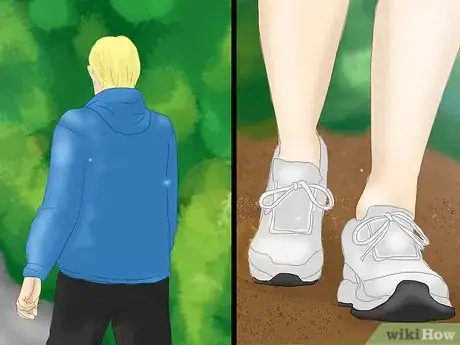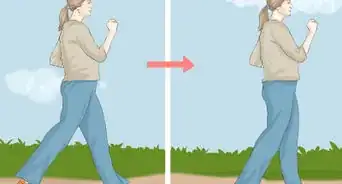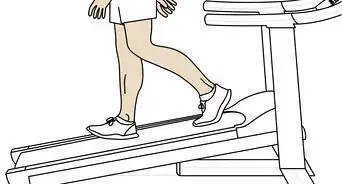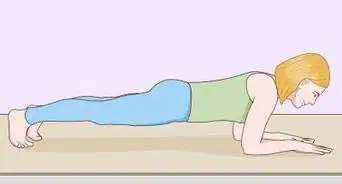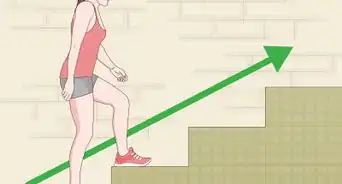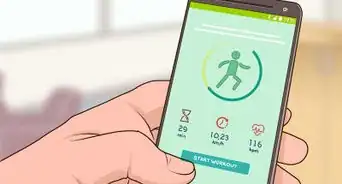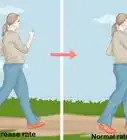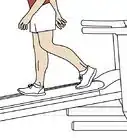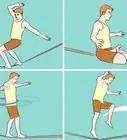This article was co-authored by Michele Dolan. Michele Dolan is a BCRPA certified Personal Trainer in British Columbia. She has been a personal trainer and fitness instructor since 2002.
There are 10 references cited in this article, which can be found at the bottom of the page.
This article has been viewed 147,310 times.
We walk for exercise - the health benefits of which are plentiful - but leisurely strolls are rare in today's fast-paced society. Walking for no other purpose than to enjoy the walk is an excellent way to live in the moment. Since we're so used to viewing walking as a means to an end, here's a primer on how to enjoy both a good old-fashioned, Zen-like saunter or a moderate exercise walk.
Steps
Strolling
-
1Keep a leisurely pace. Imagine you're walking with an elderly person. Better yet, walk with an elderly person. It's good for both of you.
-
2Relax your posture. Stick your chest out and throw your shoulders back, inhale deeply, and "relax" into that position as you exhale. Let your arms hang down freely and they'll sway as you walk. Your hips should sway from side to side as well, especially if you allow your body's weight to "sit" on one foot completely before you shift it to the other.Advertisement
-
3Look up. Don't just stare at your feet. One of the benefits of taking a relaxed stroll is that you have a chance to notice things you've never noticed before. Pay attention to your surroundings. Enjoy the scenery. Take it all in. Listen.
-
4Wander. Don't plot out a route. Don't designate a destination. As long as you can find your way back, take random turns and explore new areas. Avoid checking your watch (or if you're so inclined, learn to Tell Time Without a Clock).
-
5Meditate as you walk. Many Buddhists incorporate walking meditations into their routine. Be mindful as you walk -- be aware of what each part of your body is doing and keep your breathing even. Try to focus entirely on your body and keep your mind from being distracted by sights and sounds that dispel your mindfulness. Be aware of your path and the natural world around you. Just don’t get caught up in looking at shop windows, listening to other people’s conversations, etc. Some people find meditating easier to do while walking than while sitting still for extended periods of time.[1]
- You can also take the opportunity to Ground and Center as you walk: Imagine that every time you put your foot down, it connects with the center of the earth.[2]
Choosing Your Route
-
1Visit a forest or park. The benefits of spending time in nature are numerous. By going outside for your walk, you may experience benefits to your mental and physical health. Studies have shown that spending time in a forest can provide far reaching health benefits including reduced stress, lower blood pressure, a stronger immune system, better mood, increased focus, faster recovery from surgery or illness, more energy and better sleep.[3]
- If you live near a forest, then you might consider taking your walk on a trail through the woods.
- You could also try visiting a local park or journey to a state or national park to immerse yourself in a forest setting.
- If you live in the city or if the weather is bad, then you might try visiting an arboretum or even a botanical garden.
-
2Determine what you’d like to see. If you’re going on a stroll, part of the goal is to see pretty things -- a beautiful tree, a flower garden, stately old houses. Figure out what would make you feel happy on that particular day, and turn toward whatever it is.[4]
-
3Decide how much exercise you want to get. If you want a stroll, you’re probably not going to want lots of hills (though the views might be lovely). For maximum effect, you’re going to want to do a hike with some extreme hills. On the other end of the spectrum, you could try a walk with no hills on a paved, even surface.[5]
-
4Think about walking to work. Many of us don’t live within walking distance of work. But for those who do, walking to work can be a great way to transition from home to work and back again while getting exercise. It helps put you in the right frame of mind for each place. If you have to dress up for work, consider taking your work shoes with you and wearing walking shoes on the way to and from your destination.
-
5Be aware of dogs. Loose dogs are one of the greatest threats to walkers. Choose a route where you are unlikely to encounter dogs off lead. If you have to take a route where you know you are going to encounter loose dogs, be ready to interact.
- Stay calm. Walk away.
- Be calm, and send calm energy toward the dog. Don’t act aggressively.
- As a last resort, pretend to pick up rocks -- most dogs will get the idea and move away.
Walking for Exercise
-
1Try walking for a half hour a day. You can do it all together or break it up -- either way will give you enough exercise. You should be getting at least 150 minutes per week of moderate aerobic exercise, like walking.[6]
-
2Walk at a moderate to fast pace. It depends on you and your fitness level. It’s also up to you what you hope to achieve with walking. If you’re doing it with someone else, do you want to be able to chat as you go? If you’re pushing a stroller, do you want to move fast or slow?
-
3Keep track of your distance with an app or pedometer. Many smartphones now have pedometers built in, if you own one.[7] There are also some great apps to help keep track of your walking and motivate you further. Check out the British Heart Foundation's website for some recommendations, including MapMyWalk, Viewranger, and Walkmeter GPS.[8]
- You can also think about getting a pedometer to analyze how far you are walking daily, weekly, and monthly. Keeping track can help motivate you to continue, increase your distance, and set new walking goals.[9]
- Some more elaborate fitness meters, such as the Fitbit, will also track things like your heart rate and sleep quality.
-
4Walk with a friend. Sometimes having a partner makes all the difference. Find someone who also likes to walk for exercise -- maybe even a co-worker who would like to walk to work or a neighbor who would be interested in a morning or evening walk. If you’re not in the mood, knowing that you have a walking date will usually make you get out there even if you’re feeling tired or lazy.[10]
Expert Q&A
-
QuestionIs it better to walk before dinner or after?
 Michele DolanMichele Dolan is a BCRPA certified Personal Trainer in British Columbia. She has been a personal trainer and fitness instructor since 2002.
Michele DolanMichele Dolan is a BCRPA certified Personal Trainer in British Columbia. She has been a personal trainer and fitness instructor since 2002.
Certified Fitness Trainer Walking before dinner is a good idea if you do not have much appetite at that time of day. It may be brighter and warmer outside. There is likely to be more going on around you with many people finishing their work day. Walking after dinner, although it may be cooler and darker outside, benefits your digestion and helps regulate blood sugar. There may be fewer people around or less business-type traffic. The pace around you will probably be slower which may help you relax and enjoy the walk. Ultimately, you will feel benefits regardless of the time of day.
Walking before dinner is a good idea if you do not have much appetite at that time of day. It may be brighter and warmer outside. There is likely to be more going on around you with many people finishing their work day. Walking after dinner, although it may be cooler and darker outside, benefits your digestion and helps regulate blood sugar. There may be fewer people around or less business-type traffic. The pace around you will probably be slower which may help you relax and enjoy the walk. Ultimately, you will feel benefits regardless of the time of day. -
QuestionHow do I walk around the neighborhood if I am 12 and my guardians are afraid of me getting hit by cars, or injured somehow?
 Community AnswerAsk them to walk with you, or try negotiating with them, like maybe see if they would permit you to walk only on the less busy streets. You could also get a reflector vest or jacket so you are more visible to drivers.
Community AnswerAsk them to walk with you, or try negotiating with them, like maybe see if they would permit you to walk only on the less busy streets. You could also get a reflector vest or jacket so you are more visible to drivers. -
QuestionHow long should my walk be if I'm taking my pet rabbit with me in a pet stroller?
 Reyha TasleemCommunity AnswerIf you are taking your pet rabbit for a walk, I would recommend 15-20 minutes. It's advised to confirm with your vet doctor before you take your rabbit for a walk, to be on the safe side.
Reyha TasleemCommunity AnswerIf you are taking your pet rabbit for a walk, I would recommend 15-20 minutes. It's advised to confirm with your vet doctor before you take your rabbit for a walk, to be on the safe side.
References
- ↑ http://www.yogajournal.com/practice/773
- ↑ http://www.wildmind.org/walking/why
- ↑ http://www.dec.ny.gov/lands/90720.html
- ↑ http://www.traillink.com/top/trails.aspx
- ↑ http://www.fitday.com/fitness-articles/fitness/cardio/the-best-toning-tool-hill-walking.html
- ↑ http://www.mayoclinic.org/healthy-lifestyle/fitness/basics/aerobic-exercise/hlv-20049447
- ↑ http://lifehacker.com/the-walk-motivates-you-to-exercise-with-a-story-1481144359
- ↑ https://www.bhf.org.uk/heart-matters-magazine/activity/walking/walking-inspiration/free-walking-apps
- ↑ http://www.mayoclinic.org/healthy-lifestyle/fitness/in-depth/walking/art-20047880
About This Article
To take a leisurely walk, relax your posture, set off walking at a slow pace, and don't worry too much about planning a route or destination. Instead, focus on looking up and around at your surroundings, enjoying nature, and even meditating as you relax on your stroll. If you want to take a walk for exercise, walk at a moderate or fast pace and aim for 30 minute walking sessions every day. Using an app or pedometer to keep track of your distance as you exercise can be a great motivator! For tips on safety while you're walking, read on!











